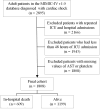Evaluation of the Aspartate Aminotransferase to Platelet Ratio Index for Predicting In-Hospital Mortality in Cardiogenic Shock Patients Admitted to the Intensive Care Unit
- PMID: 40351674
- PMCID: PMC12059761
- DOI: 10.31083/RCM26590
Evaluation of the Aspartate Aminotransferase to Platelet Ratio Index for Predicting In-Hospital Mortality in Cardiogenic Shock Patients Admitted to the Intensive Care Unit
Abstract
Backgrounds: This study aimed to investigate the conceivable utility of the aspartate aminotransferase to platelet ratio index (APRI) in prognostic prediction for patients with cardiogenic shock (CS) hospitalized in the intensive care unit (ICU).
Methods: Data for patients diagnosed with CS were obtained from the Medical Information Mart for Intensive Care-IV (MIMIC-IV) database and categorized into groups based on the APRI quartiles. The primary endpoint encompassed in-hospital and ICU mortality rates. The secondary outcomes included sepsis and acute kidney injury (AKI). Kaplan-Meier survival analysis was utilized to assess differences in main endpoints among groups categorized by their APRI.
Results: This study collected data from 1808 patients diagnosed with CS. Multivariate Cox regression analysis indicated that an elevated APRI was independently correlated with a heightened risk of in-hospital mortality (hazard ratio (HR) 1.005 [95% confidence interval (CI) 1.003-1.007]; p < 0.001) and ICU mortality (HR 1.005 [95% CI 1.003-1.007]; p < 0.001). Multivariate logistic regression analysis demonstrated that APRI was independently correlated with a heightened risk of sepsis (odds ratio (OR) 1.106 [95% CI 1.070-1.144]; p < 0.001) and AKI (OR 1.054 [95% CI 1.035-1.073]; p < 0.001).
Conclusions: An increased APRI was linked to worse clinical outcomes in critically ill patients with cirrhosis. Nevertheless, further extensive prospective investigations are needed to validate these findings.
Keywords: aspartate aminotransferase to platelet ratio index; cardiogenic shock; intensive care unit; predict.
Copyright: © 2025 The Author(s). Published by IMR Press.
Conflict of interest statement
The authors declare no conflict of interest.
Figures




Similar articles
-
[A multicenter clinical study of critically ill patients with sepsis complicated with acute kidney injury in Beijing: incidence, clinical characteristics and outcomes].Zhonghua Wei Zhong Bing Ji Jiu Yi Xue. 2024 Jun;36(6):567-573. doi: 10.3760/cma.j.cn121430-20240210-00124. Zhonghua Wei Zhong Bing Ji Jiu Yi Xue. 2024. PMID: 38991953 Chinese.
-
Blood urea nitrogen to creatinine ratio is associated with in-hospital mortality among critically ill patients with cardiogenic shock.BMC Cardiovasc Disord. 2022 Jun 8;22(1):258. doi: 10.1186/s12872-022-02692-9. BMC Cardiovasc Disord. 2022. PMID: 35676647 Free PMC article.
-
Association between the lactate-to-albumin ratio (LAR) index and risk of acute kidney injury in critically ill patients with sepsis: analysis of the MIMIC-IV database.Front Physiol. 2025 Feb 19;16:1469866. doi: 10.3389/fphys.2025.1469866. eCollection 2025. Front Physiol. 2025. PMID: 40046181 Free PMC article.
-
The optimal blood glucose is significantly associated with lower mortality in critically ill patients with cardiogenic shock: an analysis revealed with time series blood glucose records.Eur J Med Res. 2024 Feb 17;29(1):129. doi: 10.1186/s40001-024-01724-8. Eur J Med Res. 2024. PMID: 38368401 Free PMC article.
-
Association between the TyG index and the risk of in-hospital mortality from early sepsis-related acute kidney injury in critically ill patients: a secondary analysis of MIMIC-IV 2008-2022.BMJ Open. 2025 May 7;15(5):e099529. doi: 10.1136/bmjopen-2025-099529. BMJ Open. 2025. PMID: 40341153 Free PMC article.
References
LinkOut - more resources
Full Text Sources

